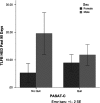Sex Differences in the Association between Heavy Drinking and Behavioral Distress Tolerance and Emotional Reactivity Among Non-Depressed College Students
- PMID: 29947730
- PMCID: PMC6454502
- DOI: 10.1093/alcalc/agy045
Sex Differences in the Association between Heavy Drinking and Behavioral Distress Tolerance and Emotional Reactivity Among Non-Depressed College Students
Abstract
Background: Heavy episodic drinking (HED) is a common behavior among college students that is associated with severe negative consequences. Negative reinforcement processes have been applied to elucidate mechanisms underlying relationships between consumption of alcohol and the desire to alleviate negative feelings. Distress tolerance (DT) and emotional reactivity are two mechanisms that are consistent with the self-medication model that may contribute to HED. The current study investigated relationships between DT, emotional reactivity, defined as frustration reactivity and irritability reactivity, and HED in a non-depressed college population. Given differential patterns of consumption and motivation for drinking between males and females, sex differences were also examined.
Short summary: The study examined two constructs consistent with negative reinforcement processes, behavioral distress tolerance (DT) and emotional reactivity (frustration reactivity and irritability reactivity), to explain heavy episodic drinking (HED) among non-depressed college students. Behavioral DT and frustration reactivity independently predicted HED. Higher HED was associated with higher frustration reactivity and lower behavioral DT in women, but nor in men.
Methods: One-hundred-ten college students without depressive symptoms completed alcohol use measures and the Paced Auditory Serial Attention Task (PASAT-C) to assess behavioral DT and emotional reactivity.
Results: DT and frustration reactivity independently predicted HED. The association between DT and HED was moderated by sex such that higher levels of DT predicted higher HED among females, but not among males. Higher frustration reactivity scores were associated with a greater number of HED.
Conclusions: Results provide supporting evidence that DT and emotional reactivity are distinct factors, and that they predict HED independently. Results underscore the importance of examining sex differences when evaluating the association between HED and negative reinforcement processes in this population.
Figures
Similar articles
-
Changes in emotional reactivity and distress tolerance among heavy drinking adolescents during sustained abstinence.Alcohol Clin Exp Res. 2014 Jun;38(6):1761-9. doi: 10.1111/acer.12415. Epub 2014 May 12. Alcohol Clin Exp Res. 2014. PMID: 24818520 Free PMC article.
-
Depressive Symptoms and Drinking Outcomes: The Mediating Role of Drinking Motives and Protective Behavioral Strategies Among College Students.Subst Use Misuse. 2018 Jan 2;53(1):143-153. doi: 10.1080/10826084.2017.1327974. Epub 2017 Aug 16. Subst Use Misuse. 2018. PMID: 28813174
-
Reasoned and implicit processes in heavy episodic drinking: An integrated dual-process model.Br J Health Psychol. 2020 Feb;25(1):189-209. doi: 10.1111/bjhp.12401. Epub 2019 Dec 26. Br J Health Psychol. 2020. PMID: 31876984
-
How executive functioning moderates the relation between implicit alcohol associations and heavy episodic drinking: The roles of planning and working memory.Exp Clin Psychopharmacol. 2024 Aug;32(4):379-385. doi: 10.1037/pha0000690. Epub 2023 Nov 2. Exp Clin Psychopharmacol. 2024. PMID: 37917505
-
Distress tolerance in social versus solitary college student drinkers.Addict Behav. 2015 Nov;50:89-95. doi: 10.1016/j.addbeh.2015.06.025. Epub 2015 Jun 11. Addict Behav. 2015. PMID: 26114980
Cited by
-
Prelimbic Cortex Activity during a Distress Tolerance Task Predicts Cocaine-Seeking Behavior in Male, But Not Female Rats.J Neurosci. 2023 Jan 25;43(4):647-655. doi: 10.1523/JNEUROSCI.1718-22.2022. Epub 2022 Dec 9. J Neurosci. 2023. PMID: 36639895 Free PMC article.
-
Development of Comorbid Alcohol Use and Depressive Symptoms During Late Adolescence: Examining the Roles of Emotion Regulation and Gender Differences.Res Child Adolesc Psychopathol. 2024 Dec;52(12):1931-1943. doi: 10.1007/s10802-024-01251-4. Epub 2024 Sep 28. Res Child Adolesc Psychopathol. 2024. PMID: 39340743
-
Large-scale brain network activation during emotional inhibitory control: Associations with alcohol misuse in college freshmen.Alcohol Clin Exp Res. 2022 Mar;46(3):410-421. doi: 10.1111/acer.14782. Epub 2022 Feb 15. Alcohol Clin Exp Res. 2022. PMID: 35084060 Free PMC article.
-
Distress tolerance and emotional regulation in individuals with alcohol use disorder.Front Psychiatry. 2023 May 12;14:1175664. doi: 10.3389/fpsyt.2023.1175664. eCollection 2023. Front Psychiatry. 2023. PMID: 37252141 Free PMC article.
-
A biological framework for emotional dysregulation in alcohol misuse: from gut to brain.Mol Psychiatry. 2021 Apr;26(4):1098-1118. doi: 10.1038/s41380-020-00970-6. Epub 2020 Dec 7. Mol Psychiatry. 2021. PMID: 33288871 Review.
References
-
- Armeli S, Todd M, Conner TS, et al. (2008) Drinking to cope with negative moods and the immediacy of drinking within the weekly cycle among college students. J Stud Alcohol Drugs 69:313–22. - PubMed
-
- Bandura A. (1986) Social foundations of thought and action: A social cognitive theory. Englewood Cliffs, NJ: Prentice-Hall.
MeSH terms
Grants and funding
LinkOut - more resources
Full Text Sources
Other Literature Sources
Medical


